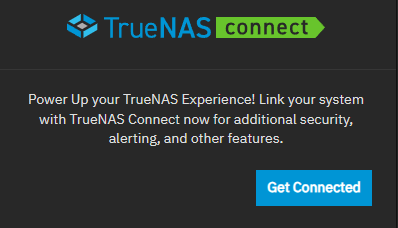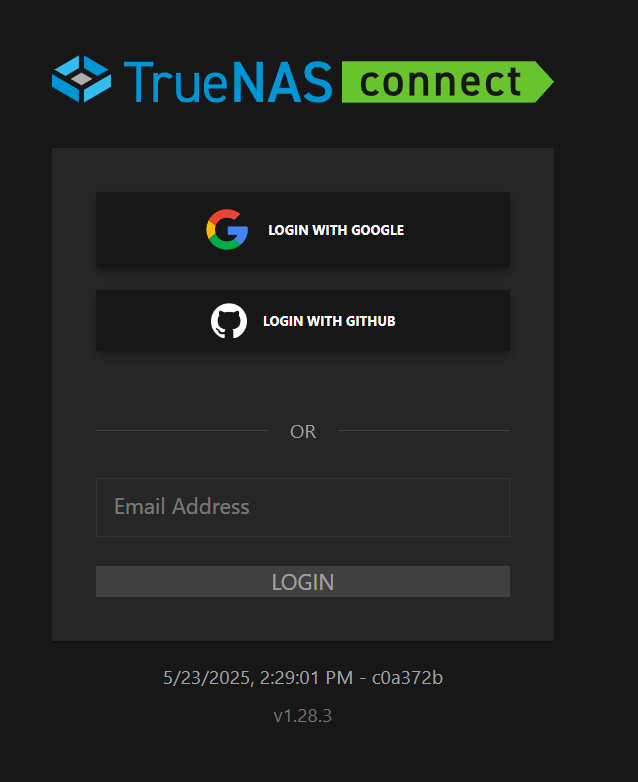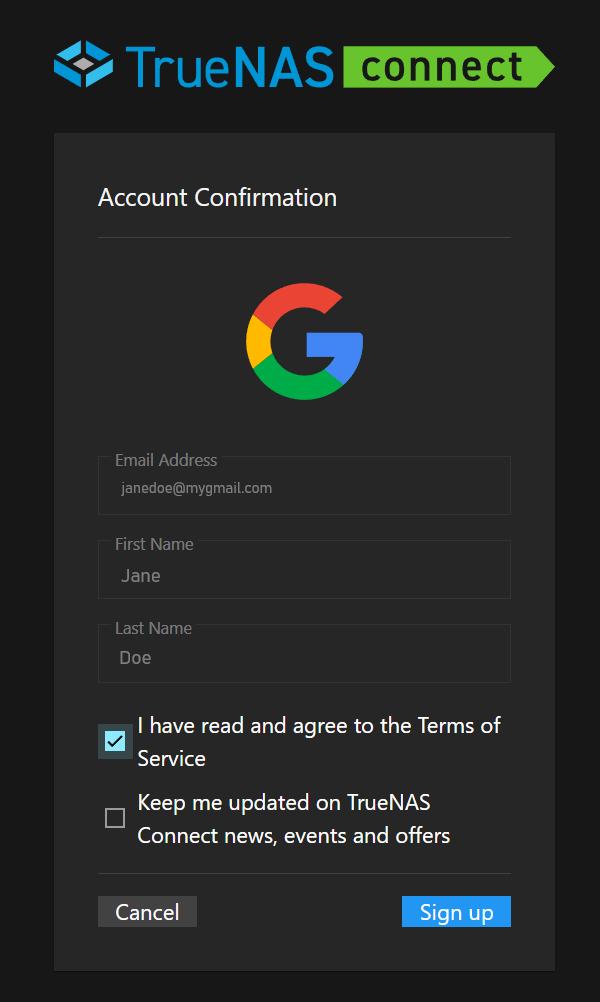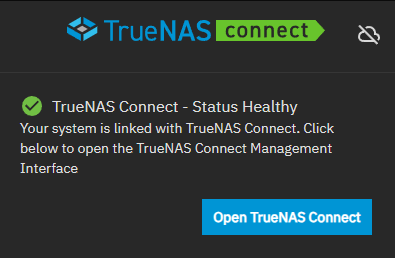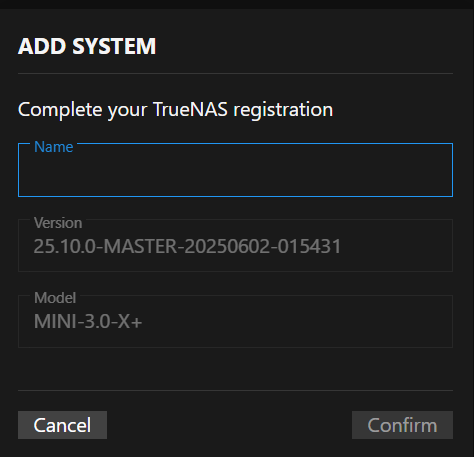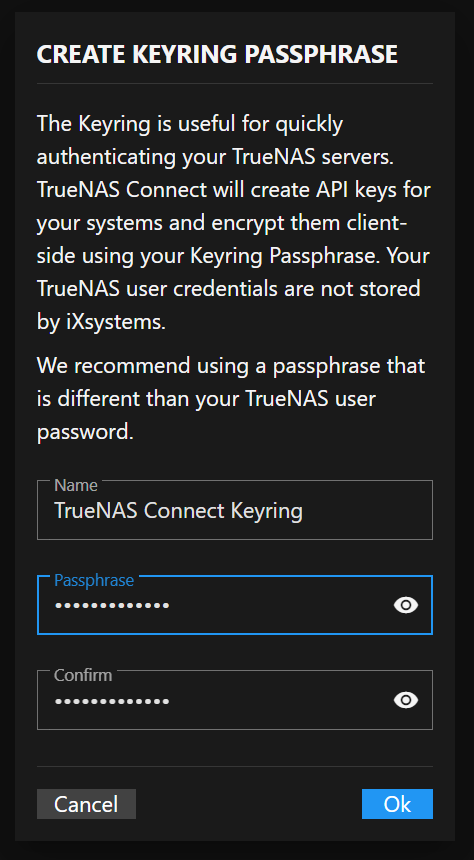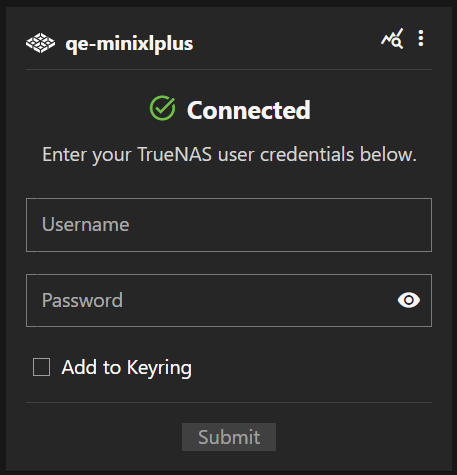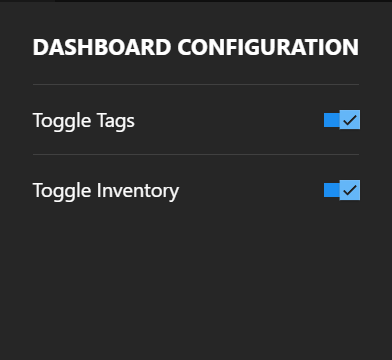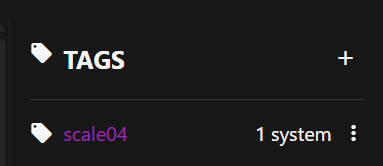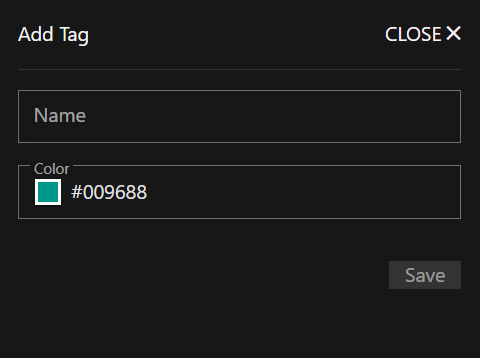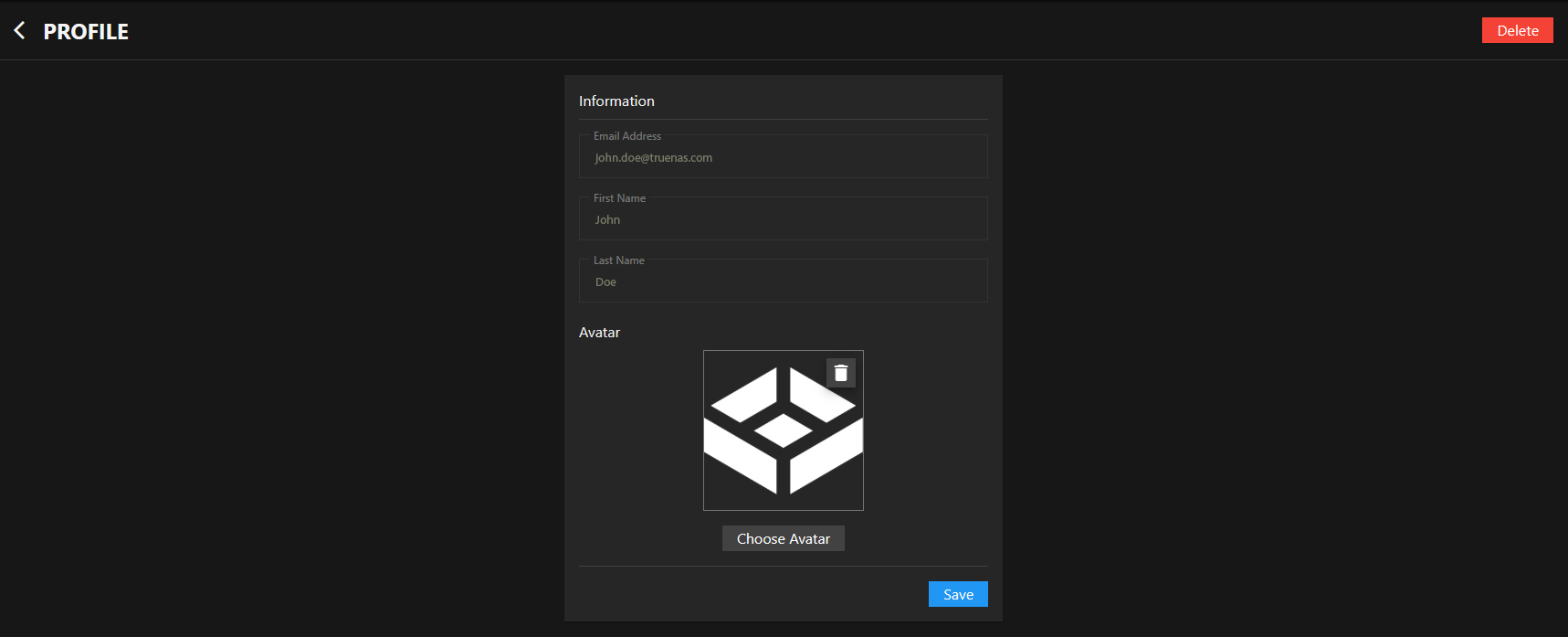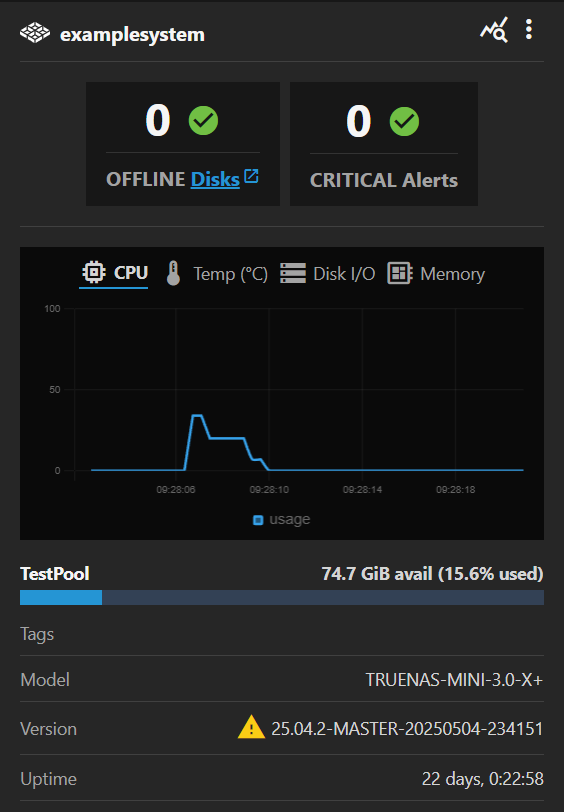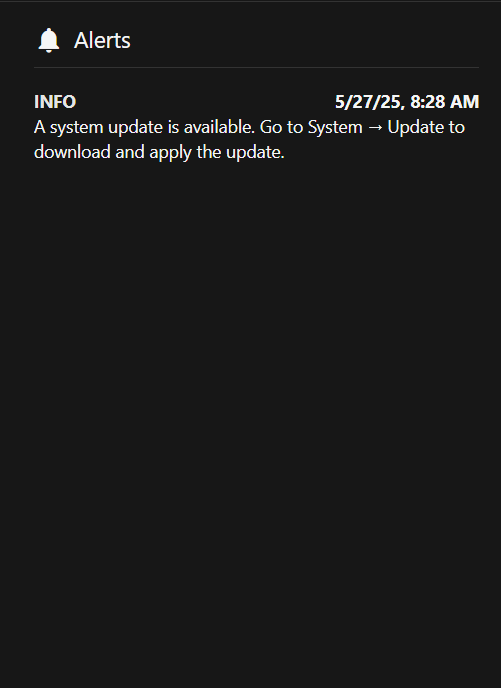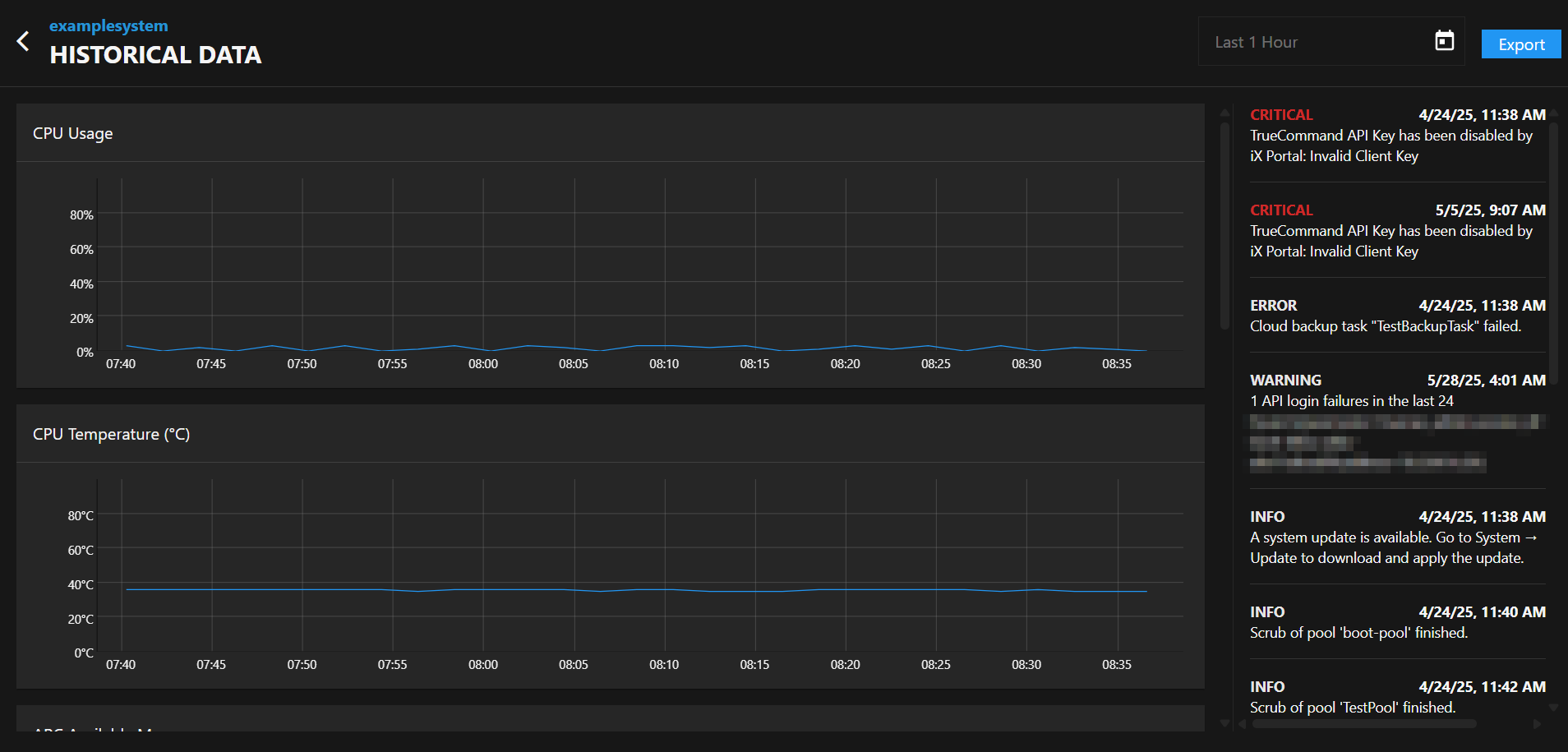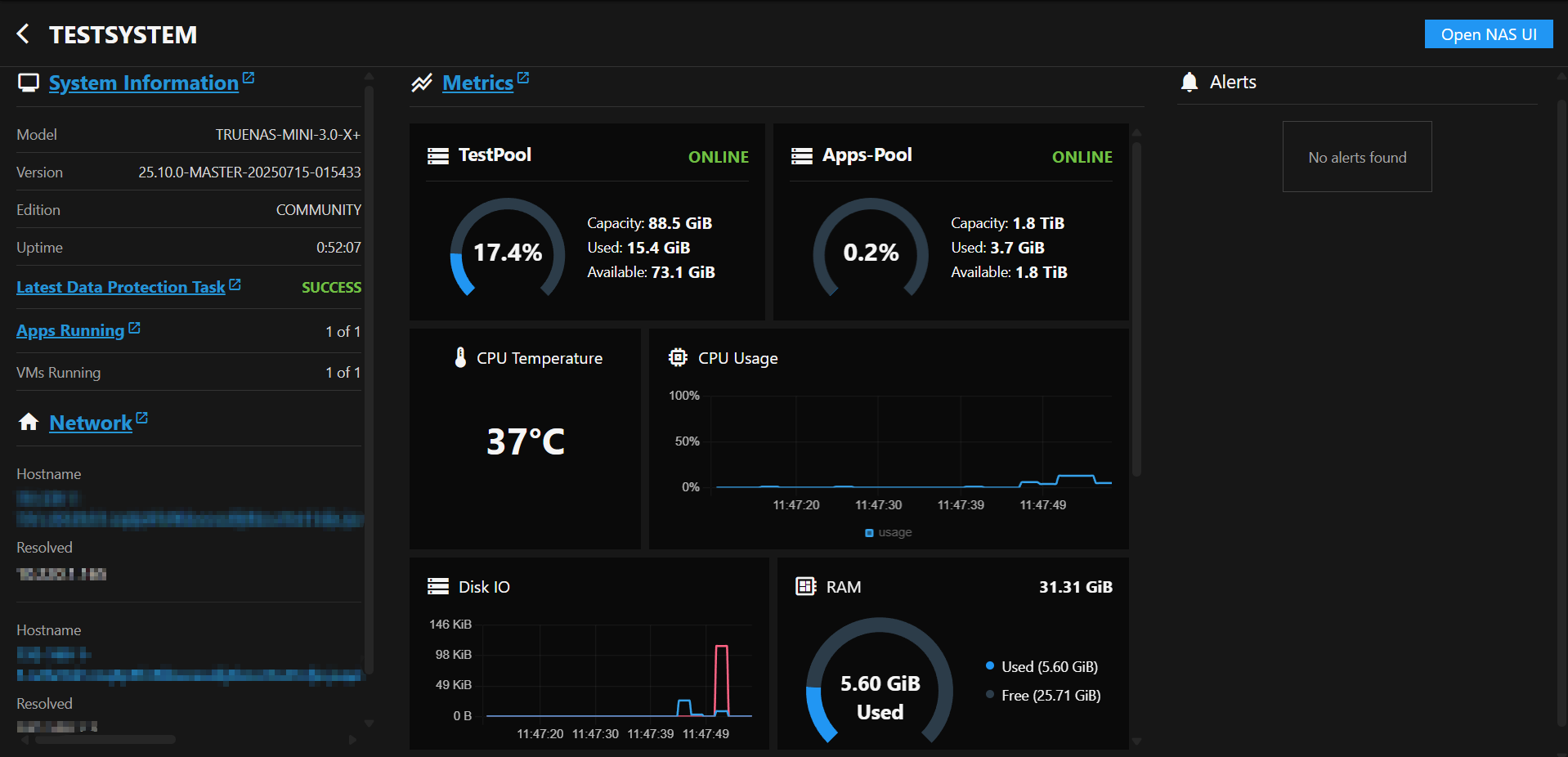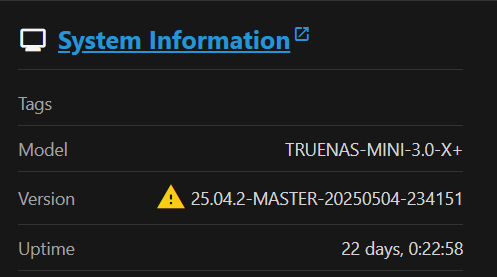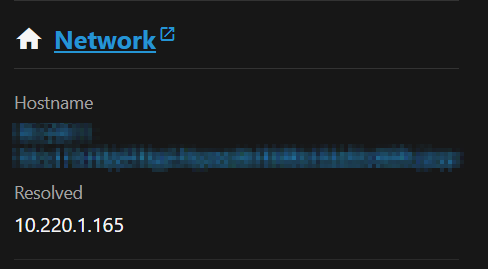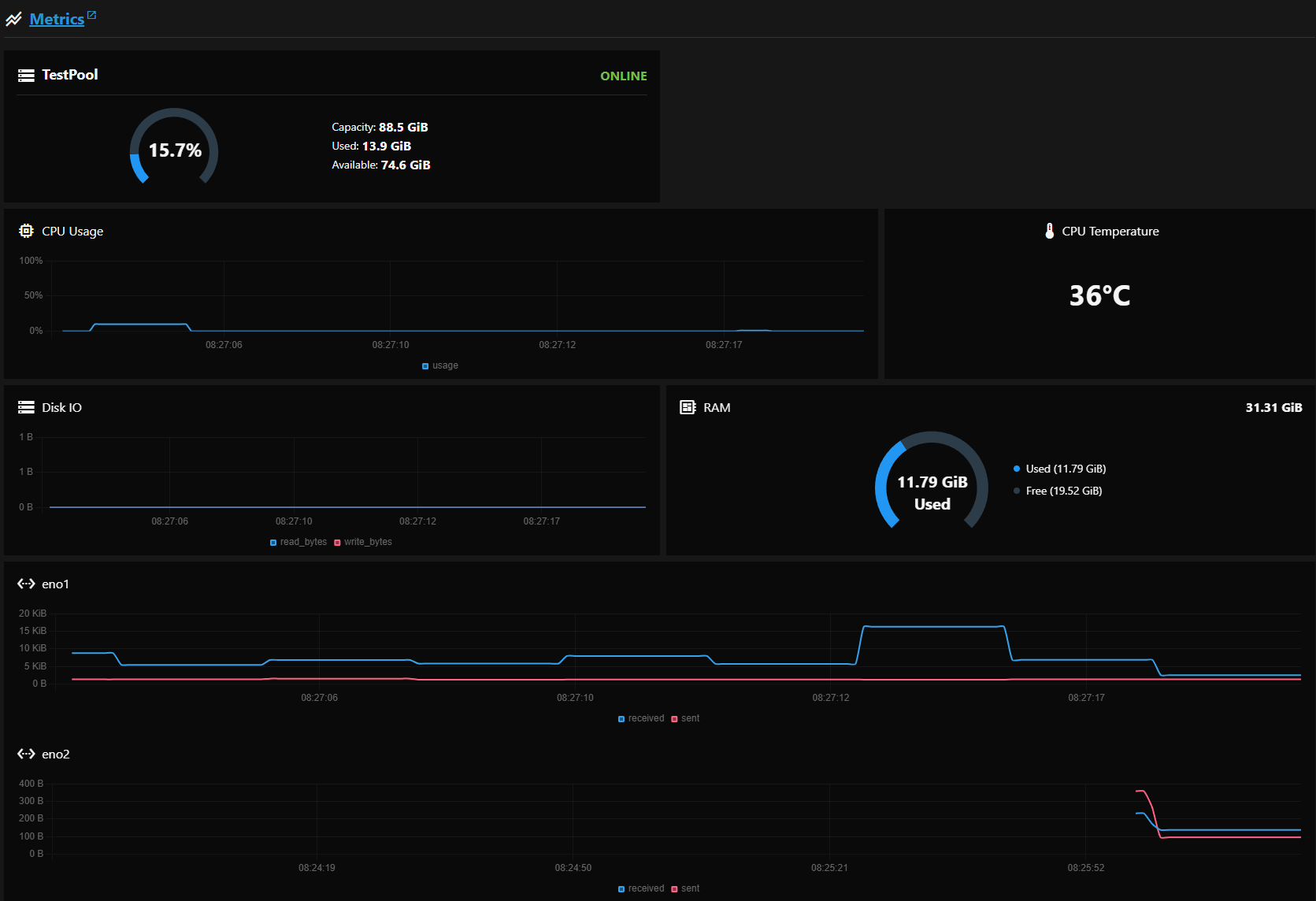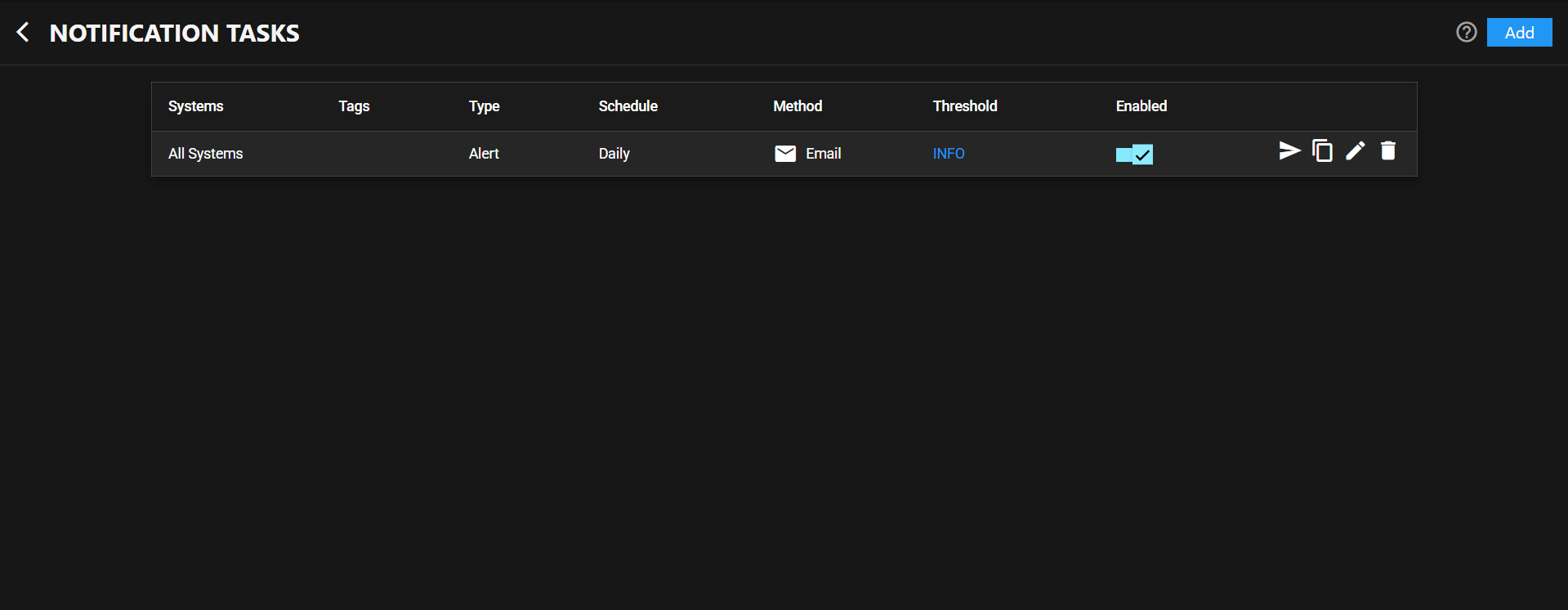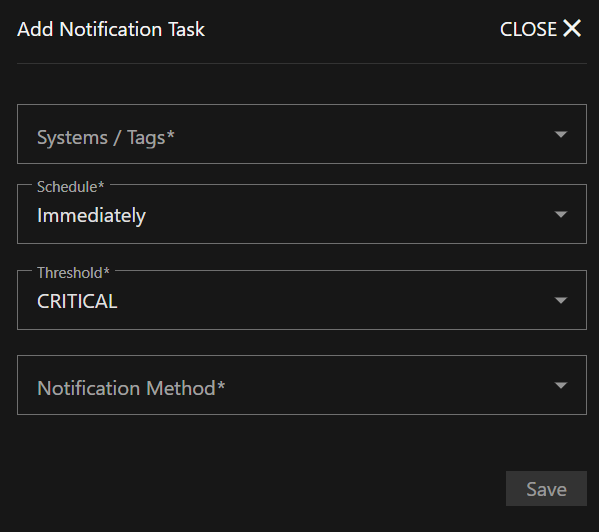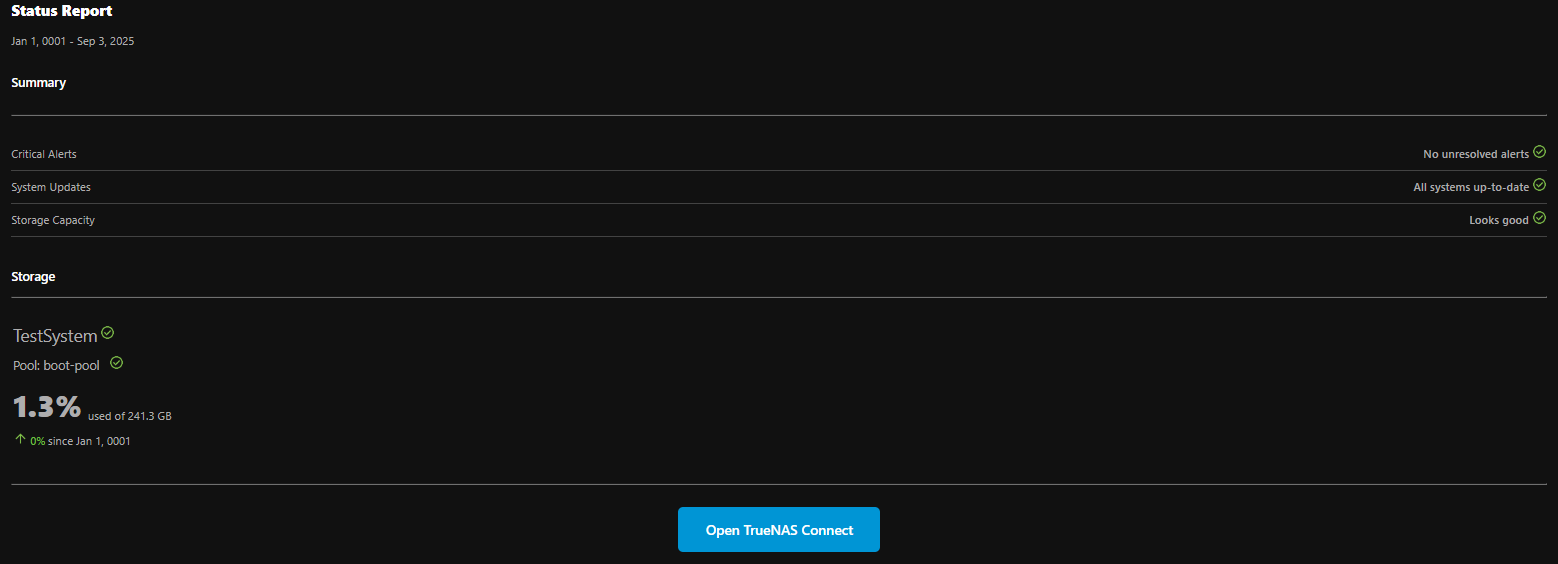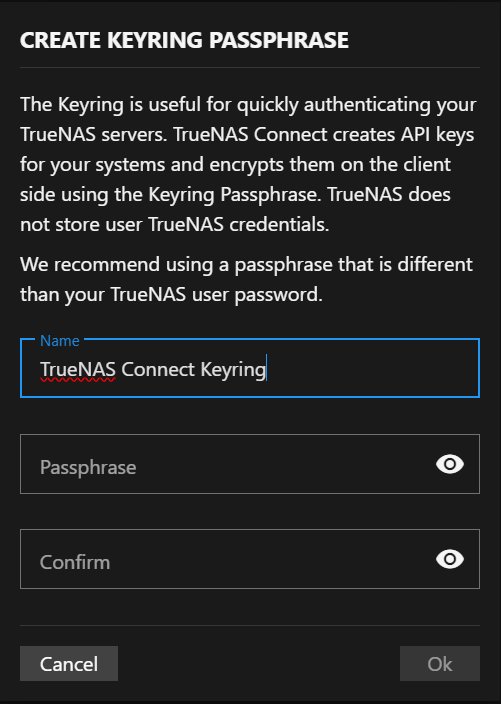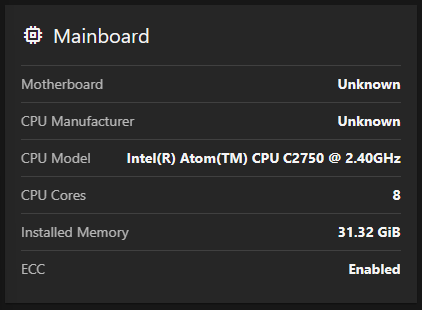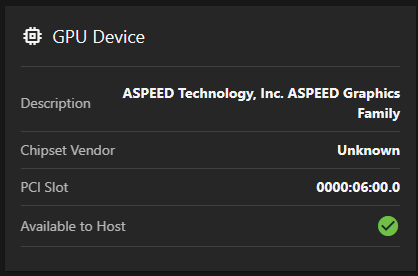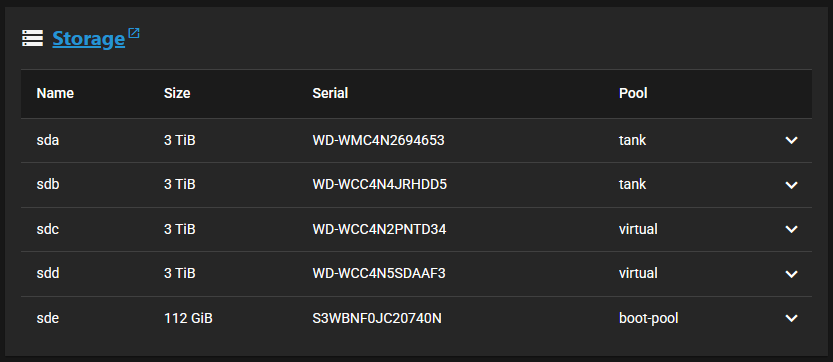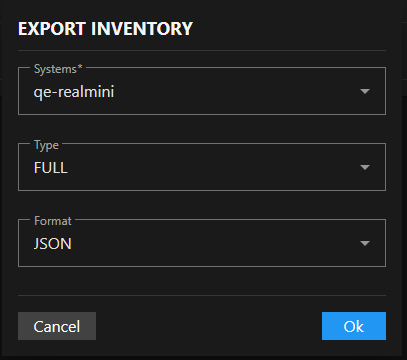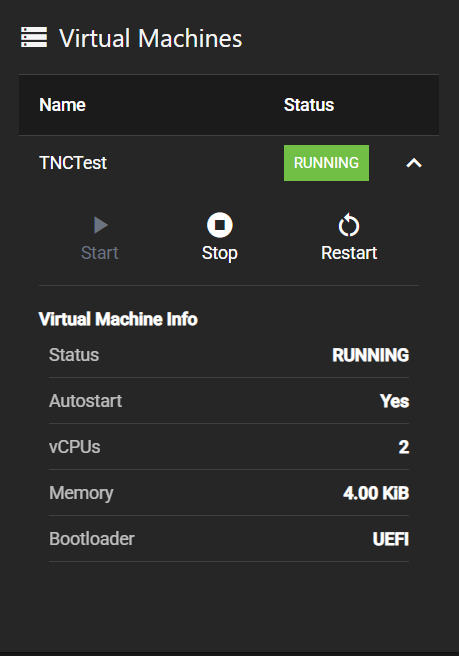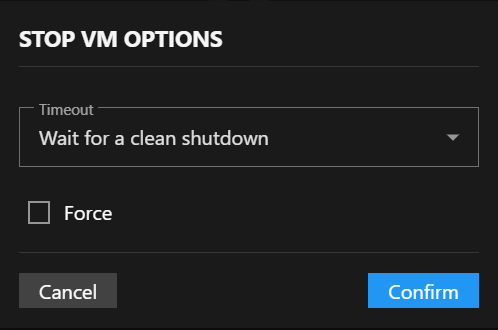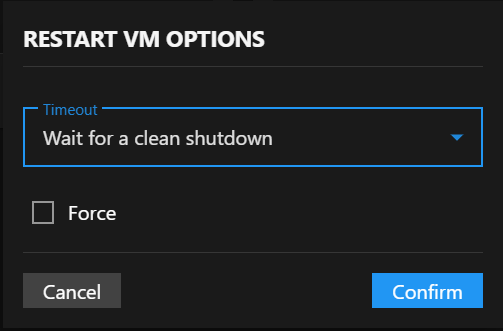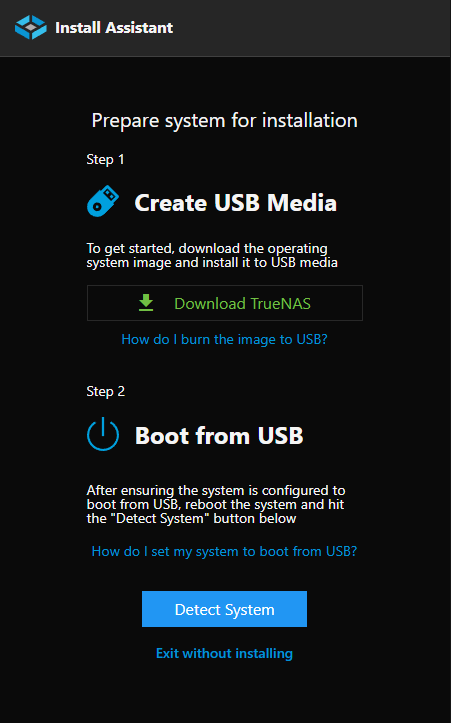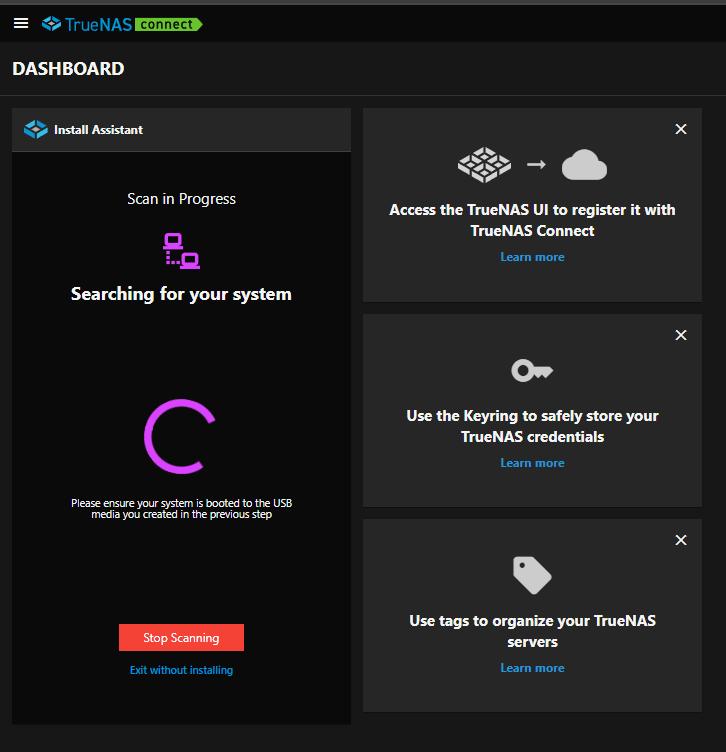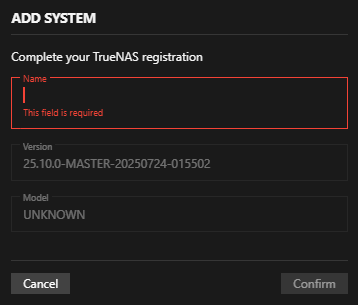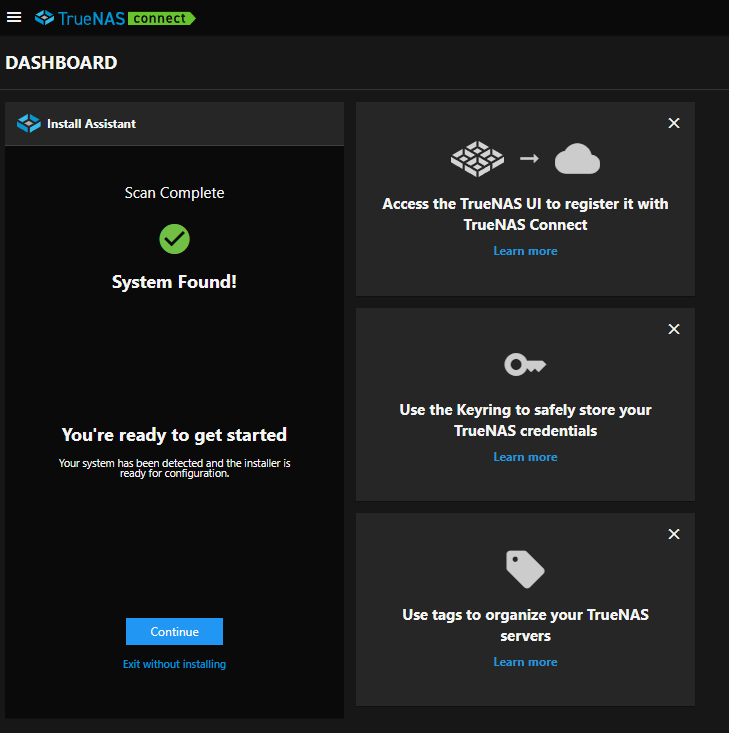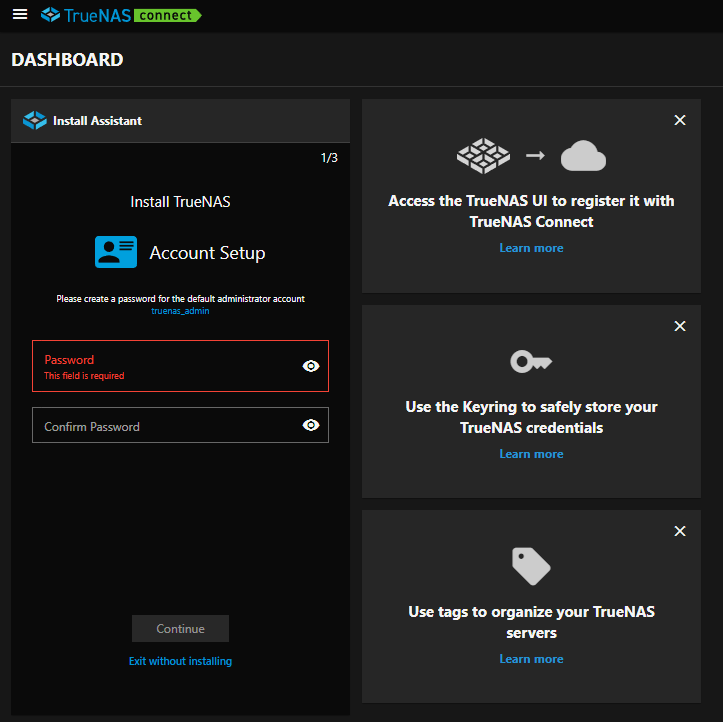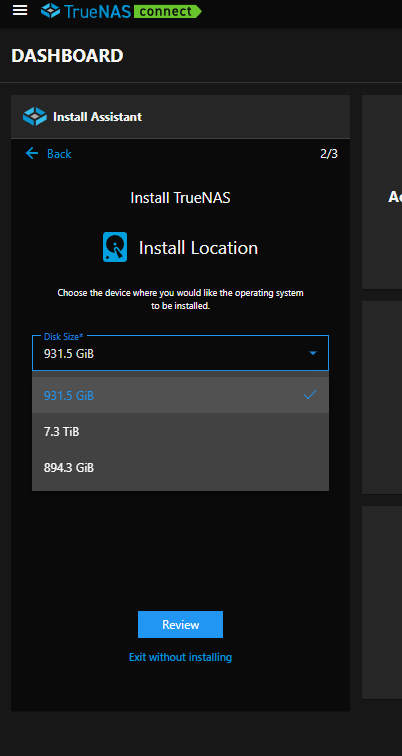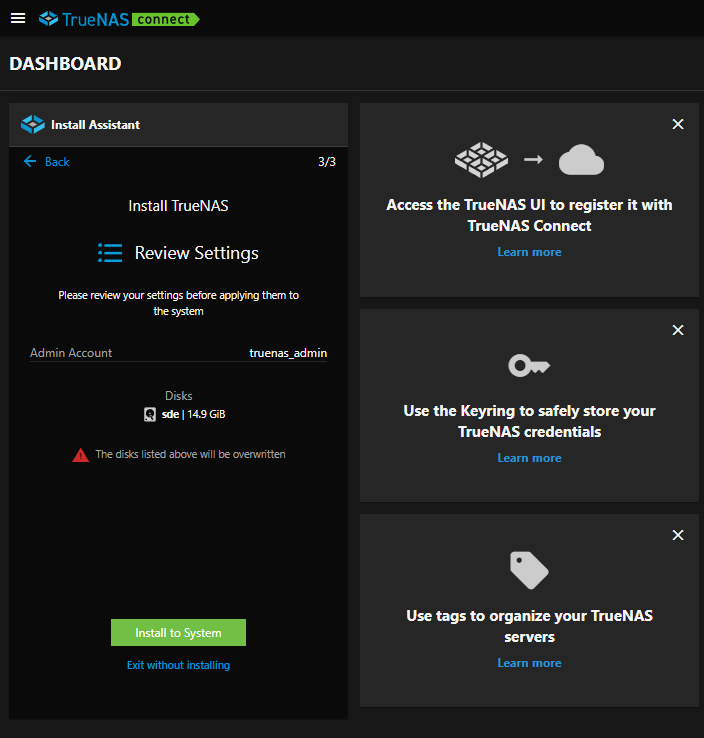This is the multi-page printable view of this section. Click here to print.
Tutorial
- 1: Getting Started with TrueNAS Connect
- 2: Health Reporting
- 3: Managing the Keyring
- 4: Managing TrueNAS Systems Inventory
- 5: Managing Virtualization
- 6: TrueNAS Web Install
1 - Getting Started with TrueNAS Connect
Accessing TrueNAS Connect the first time is as easy as clicking on the top toolbar Status of TrueNAS Connect icon located in your TrueNAS system UI. All that is required is full administration access to the TrueNAS server and an OAuth account.
Setting Up TrueNAS Connect
Begin by logging into the TrueNAS server as an administrator. After logging into your TrueNAS system as a full administrator, click on the TrueNAS Connect icon to open the TrueNAS Connect dialog.
Before you sign up for TrueNAS Connect, the dialog shows it is waiting to connect.
Click Get Connected to open the TrueNAS Connect login screen.
Choose the OAuth provider you want to use to log into TrueNAS Connect. The OAuth account used is registered as the authentication account for TrueNAS Connect.
You can use an existing OAuth account or create a new account. The option to use an email account is planned for a future update.
Follow the sign-in process for your chosen OAuth provider until you reach the Account Confirmation window. Click the link on the Account Confirmation window to view the Terms of Service.
Read the Terms of Service, then select the option to indicate that you read and agree to the Terms of Service.
Select the option to receive updates on TrueNAS Connect news, events, and offers to receive notifications from TrueNAS Connect.
Click Sign Up to open the TrueNAS Connect Dashboard.
TrueNAS Connect prompts you to complete the system registration and add the system to TrueNAS Connect. After adding the system, a system information card shows on the main Dashboard screen.
Repeat this process for each TrueNAS system you want to add to TrueNAS Connect.
After adding your system, you can customize the interface.
On TrueNAS, after connecting to TrueNAS Connect and registering the system, the Status of TrueNAS Connect icon shows an active status indicator. The TrueNAS Connect dialog shows the status of the active connection.
Click Open TrueNAS Connect to open the TrueNAS Connect management interface. Click cloud_off Disable Service to disconnect the system from TrueNAS Connect.
Logging In Using a Google Account
To sign into TrueNAS Connect with a Google account, click Login with Google. The Sign In with Google window opens. Choose the Google account you want to use to register your system in TrueNAS Connect.
If using an existing Google account, enter the email or phone number and click Continue. Select the existing Google account to use for the TrueNAS Connect authentication and credentials to log into TrueNAS Connect. Confirm the account on the Account Confirmation window as described above in Setting Up TrueNAS Connect.
If creating a new account, click Create Account and follow the Google account creation process until you reach the Account Confirmation window for TrueNAS Connect.
After completing the account confirmation, the TrueNAS Connect main Dashboard shows and prompts you to register your system.
Logging In Using a GitHub Account
To sign into TrueNAS Connect with a GitHub account, click Login with GitHub. The Select user to authorize window opens. Sign in with your existing GitHub account or click Use a different account to choose an account or create a new Google account.
If using an existing GitHub account, enter the user account name or the email associated with the account, then click Sign In. Follow the GitHub authentication process until the Account Confirmation window shows. Confirm the account on the Account Confirmation window as described above in Setting Up TrueNAS Connect.
If creating a new account, follow the GitHub account creation process until you see the Account Confirmation window for TrueNAS Connect. After completing the account confirmation, the TrueNAS Connect main dashboard opens and the system prompts you to register your system.
Registering a System
After logging into TrueNAS Connect, you are prompted to complete the system registration using the Add System dialog.
Enter a name for your system, such as the host name or a name that helps identify the purpose of the system. For example, backup1, TNserver1, etc. Click Confirm to add the system.
To register another system, begin in the TrueNAS system UI. Log into the TrueNAS system UI as an administrator with full admin privileges. Follow the instructions provided in Setting Up TrueNAS Connect to log into TrueNAS Connect using the same OAuth account used to set up TrueNAS Connect.
Repeat this for each system you want to add to TrueNAS Connect.
Adding a Keyring
Keyrings are useful for quickly authenticating your TrueNAS servers with an API key.
To add a keyring, click Create Keyring. The Create Keyring Passphrase window opens.
Enter a name for the system in Name, then enter a complex passphrase in both Passphrase and Confirm. Click Ok to add the keyring.
You can apply one keyring to all your systems. Select the Add to Keyring option on the system card where you enter the credentials to log into each system.
Unlocking a System
After logging out of TrueNAS Connect, the Unlock Keyring dialog shows when you sign in again. Enter your passphrase for the keyring to authenticate system access. If you include other systems in the keyring, each included system is authenticated with the keyring. Authenticated systems show the system cards populated with information received from the TrueNAS on the Dashboard.
Customizing TrueNAS Connect
Customizing the Dashboard
You can customize the main Dashboard to show the Tags and/or Inventory widgets. Click Configure at the top right of the main dashboard screen to show the Dashboard Configuration dialog.
Select Toggle Tags to show or hide the Tags widget. Tags lists system tags created in TrueNAS Connect, and an option to add tags for other systems. If you hide the Tags widget, you can add tags from the Tags option on the main menu dropdown.
Select Toggle Inventory to show or hide the Inventory widget that lists systems by name on the right side of the dashboard. Each system listed in the Inventory widget shows a Visibility icon that toggles showing or hiding the system information card on the main dashboard.
Customizing Your Profile and Avatar
You can customize your TrueNAS Connect account profile by viewing your account information and setting a custom avatar image.
To access your profile settings, click the Profile option in the main navigation menu.
Viewing Profile Information
Your profile displays your account information including your email address, first name, and last name.
Profile information fields (Email Address, First Name, and Last Name) are read-only and display the information from your account used to authenticate with TrueNAS Connect.
Setting Your Avatar
You can personalize your TrueNAS Connect account by uploading a custom avatar image.
To upload an avatar:
- In the Avatar section, click Choose Avatar
- Select an image file from your computer (JPG, PNG, or WebP format)
- Click Save to apply your new avatar
Your avatar image appears throughout TrueNAS Connect, including in the main navigation and system cards.
If you want to remove your current avatar, click the button to return to the default profile icon.
2 - Health Reporting
Using Dashboard Reporting Features
Users can find the system card(s) with health reporting widgets on their TrueNAS Connect dashboard.
OFFLINE Disks and CRITICAL Alerts statistics are found at the uppermost border of the widget, and can be used to quickly track the number of critical errors on any connected TrueNAS system.
The live-reporting graph defaults to the disk I/O rates, but can be toggled to temperature reporting, CPU usage, and memory usage by clicking the applicable icons.
Below the graph, currentl storage insights for TrueNAS datasets are shown.
Users can also locate the most recent tags, model, version, and uptime statistics on their TrueNAS systems at the bottom of the dashboard health reporting widget.
Viewing TrueNAS Alerts
Click CRITICAL Alerts to open the alerts panel for that system. On the far right, all TrueNAS system alerts are available.
Viewing Historical Alert Data
On free-tier TrueNAS Connect accounts, alerts remain in the TrueNAS Connect alert column for as long as the alerts stay in the TrueNAS UI. After alerts are cleared from the TrueNAS UI, they disappear from the TrueNAS Connect alert column.
Alert retention periods vary by account tier, with extended historical data available for higher-tier accounts. To locate system Historical Data, click on the icon located in the top right corner of the dashboard system card. From the dropdown menu, click Historical Data.
Using the System Info Screen
Click on the query_stats icon on a system card to go to the system info screen.
Viewing System Information
In the System Information section of the system info screen, users can find applied tags, model numbers, version numbers, and total system uptime.
Viewing Network Information
Users can also view the Network details of their TrueNAS systems from the system info screen, including the system hostname and IP address.
Viewing Metrics
From the system info screen, users can access an expanded view of live-reporting graphs on their systems. These graphs include: memory usage, CPU usage, CPU temperature, disk I/O RAM usage, eno1 data transfer rates, and eno2 data transfer rates.
Using Notification tasks
TrueNAS Connect provides automated reporting for users through the Notification Tasks screen. To open the Notification Tasks screen, click the icon in the top toolbar to open the TrueNAS Connect side menu. Click Notification Tasks.
Viewing and Managing Notification Tasks
The Notification Tasks table displays all configured notification tasks.
Adding Notification Tasks
Click Add to open the Add Notification Task screen.
Notification Type
Select the type of notification to create:
- Alert - Sends notifications when alert conditions are triggered based on the threshold settings
- Report - Sends automated reports containing system performance data, storage insights, alert summaries, and predictive analysis
Schedule
Select the frequency to receive notifications for the current task.
For Alert notifications: Select Immediately to have notifications sent as soon as the alert level is triggered or select Hourly, Daily, Weekly, or Monthly to schedule periodic notifications.
For Report notifications: Select Hourly, Daily, or Weekly to schedule automated report delivery.
Threshold
Select the level of alert severity to associate with this notification task. Select CRITICAL, ERROR, WARNING, or INFO to receive notifications for all alerts at the selected level and above.
For example, a notification task set to Immediately and WARNING immediately sends notifications for all at or above the WARNING level, including ERROR and CRITICAL.
Notification Method
Select the contact type for this notification task. Options include Email, Sms text message, Slack, and Pagerduty.
Configure contact account or address details for the selected method in Notification Method Configuration.
Report Content
Automated reports include high-level data points useful for all user personas:
- Storage availability and usage - Pool-level storage metrics and usage trends since last report
- Predictive analysis - Forecasts when storage usage will exceed recommended thresholds
- Available updates - Notifications about TrueNAS system updates and application updates
- Alert history - Summary of critical, error, and warning alerts with resolution status
- Call-to-action link - Direct access to TrueNAS Connect interface for detailed analysis
Enterprise Customization
As users increase TrueNAS Connect tier status, reports become more customizable with additional Enterprise-tier metrics:
- CPU consumption (average and peak usage)
- Memory consumption (average and peak usage)
- Network throughput and roundtrip time statistics
- Storage latency data
- Replication status and duration metrics
- Dataset quota insights and snapshot counts
- TrueNAS access auditing (login activity)
- Critical VM uptime statistics
Configuring Automatic Email Reports
TrueNAS Connect provides automated email reports that deliver comprehensive system insights directly to your inbox. These reports offer peace of mind when systems operate within acceptable parameters and provide actionable information when performance or resource usage becomes abnormal.
To configure automatic email reports:
- From the Notification Tasks screen, click Add
- Select the systems you want to monitor from the Systems/Tags dropdown
- Choose Report as the notification type
- Select your preferred schedule (Hourly, Daily, or Weekly)
- Set the Threshold level for alert summaries to include in reports
- Choose Email as the Notification Method
- Click Save to create the automated report task
Understanding Report Contents
Automated email reports contain comprehensive data points designed to be informative and engaging for all user personas:
Standard Report Features
All TrueNAS Connect users receive reports containing:
Storage Insights: Pool-level availability and usage statistics
- Current storage utilization (e.g., 4TiB / 8TiB (50% used))
- Usage changes since last report (e.g., tank’s available storage decreased by 3.3%)
Predictive Analysis: Forecasting capabilities that help prevent issues before they arise
- Storage threshold predictions (e.g., tank’s used storage will exceed 80% in 3 months)
Update Notifications: System and application update availability
- TrueNAS version updates (e.g., A new stable TrueNAS version is available for Campbell Backup)
- Application security updates (e.g., The Plex app can be updated to address two CVEs)
Alert History: Comprehensive alert summaries
- Alert counts by severity level
- Resolution status for critical issues
- Historical alert trends
Call-to-Action: Direct link to TrueNAS Connect interface for detailed analysis and drill-down capabilities
Enterprise Customization Options
Enterprise-tier TrueNAS Connect users can customize their automated reports with additional metrics:
- Performance Metrics: CPU consumption (average and peak), memory usage statistics
- Network Analytics: Average throughput, peak roundtrip time data
- Storage Performance: Latency measurements and performance insights
- Replication Monitoring: Status updates, data volumes, and task duration analytics
- Resource Management: Dataset quota insights and snapshot count summaries
- Security Auditing: TrueNAS access logs showing login activity and timing
- Virtual Machine Health: Uptime statistics for critical VMs
Benefits of Automatic Email Reports
Automated reports serve multiple purposes in your TrueNAS infrastructure management:
- Proactive Monitoring: Receive predictive insights that help address issues before they impact operations
- Operational Visibility: Stay informed about fleet performance without actively monitoring individual systems
- Historical Context: Track trends and changes over time to understand system behavior patterns
- Actionable Intelligence: Get specific recommendations and alerts that require attention
- Streamlined Management: Access detailed information through convenient email delivery with direct links to the TrueNAS Connect interface for deeper analysis
Reports are designed to be engaging and informative regardless of technical expertise, with clear data presentation and actionable recommendations that motivate users to investigate further through the TrueNAS Connect interface.
3 - Managing the Keyring
The TrueNAS Connect keyring provides secure, encrypted storage for your TrueNAS system keys, enabling automatic authentication when accessing your systems through TrueNAS Connect.
This tutorial walks you through creating a keyring, adding systems to it, and managing your keyring.
Understanding the Keyring
TrueNAS Connect automatically creates a key when you register your system in TrueNAS Connect. The keyring encrypts and stores keys client-side using a passphrase you create. This allows TrueNAS Connect to automatically authenticate with your systems without storing your TrueNAS user credentials.
Key benefits of using a keyring:
- Automatic authentication: No need to manually enter credentials for each system
- Client-side encryption: Your keys are encrypted locally using your passphrase
- Secure storage: TrueNAS user credentials are never stored by TrueNAS Connect
- Quick access: Unlock all connected systems at once with a single passphrase
Creating Your First Keyring
When you first access TrueNAS Connect, you need to create a keyring to enable automatic authentication.
When no keyring exists, the top toolbar displays a Create Keyring button. Click this button to open the Create Keyring Passphrase dialog and begin creating your keyring.
Setting Up Your Keyring Passphrase
On the Create Keyring Passphrase dialog:
Enter an identifier for your keyring in Name (e.g., MyTrueNAS-Keyring).
Enter a strong passphrase for encrypting your keys in Passphrase. Choose a unique passphrase distinct from your TrueNAS system passwords and your OAuth account password, that is something memorable but secure.
Re-enter your passphrase in Confirm.
Click Ok to create the keyring.
The Ok button remains disabled until all fields are completed and the entered passphrases match.
Adding Systems to Your Keyring
After creating your keyring, you can add your other TrueNAS systems to enable automatic authentication.
Adding During System Authentication
You can add a system to your keyring during the authentication process.
From the Dashboard, locate the system card you want to add. Enter the system authentication credentials, and then select the Add to Keyring option.
Complete the authentication process. A system key is automatically created, encrypted, and stored in your keyring.
Viewing Keyring
To see which systems are stored in your keyring:
Go to the Keyring screen. The TrueNAS Systems table, shows the system name in the TrueNAS column, Key shows Stored when an key is saved, or is blank if ones is not stored. Connected shows true for successful connections, or false for failed connections.
You can go to the TrueNAS UI My API Keys to see the TrueNAS Connect API key.
Unlocking Your Keyring
After setting up a keyring, each time you sign into TrueNAS Connect the Unlock Keyring dialog automatically opens, and prompts you to enter your passphrase to unlock the keyring.
- Enter your keyring passphrase.
- Click Ok to unlock all systems in the keyring. All systems with stored keys are automatically authenticated, and the system information cards on the dashboard populate with system data.
If you click Cancel, you need to authenticate each system individually using TrueNAS system credentials.
Managing Your Keyring
Resetting the Keyring
If you need to remove all stored keys and start over:
- Go to the Keyring screen.
- Click the Reset button in the header.
- Review the confirmation dialog warnings.
- Click Ok to proceed with the reset, or Cancel to keep your existing keyring
After a Keyring Reset
After resetting a keyring, system included in the keyring require manual authentication the next time you sign into TrueNAS Connect. You need to re-enter system credentials for each system individually.
If you want to rebuild your keyring, create a new keyring using the Create Keyring button on the top toolbar. Remember to check Add to Keyring when re-authenticating.
Best Practices
The TrueNAS Connect keyring streamlines access to your TrueNAS systems by:
- Providing secure, encrypted storage for keys
- Enabling automatic authentication across all your systems included in the keyring
- Eliminating the need to enter individual system credentials each time you sign into TrueNAS Connect
- Maintaining security through client-side encryption
With your keyring properly configured, you can focus on managing your TrueNAS systems rather than repeatedly entering authentication credentials.
Passphrase Security
When choosing a passphrase for the keyring:
- Create a unique passphrase distinct from your TrueNAS system passwords and your OAuth account password.
- Choose a passphrase that is memorable but secure.
- Consider using a passphrase manager for complex passphrases.
Troubleshooting Authentication
If a system shows false in the Connected column, check:
- The TrueNAS system is online and accessible
- The stored key hasn’t expired or been revoked
- The network connectivity between TrueNAS Connect and your system is stable
Re-authenticate the system if needed and add it back to the keyring.
4 - Managing TrueNAS Systems Inventory
TrueNAS Connect provides comprehensive inventory management capabilities that allow you to view detailed hardware information, disk specifications, and system components across all connected TrueNAS systems from a centralized interface.
Why Use Inventory Management
Inventory management helps you:
- Monitor fleet health: Quickly identify systems with hardware issues or capacity constraints
- Plan upgrades: Track hardware specifications to determine which systems need updates
- Maintain compliance: Generate hardware reports for audits and asset management
- Troubleshoot efficiently: Access detailed hardware information when diagnosing problems
- Optimize resources: Understand your available storage and processing capacity across all systems
Accessing the Inventory Screen
To begin managing your system inventory:
- Open the TrueNAS Connect side menu by clicking the icon in the top toolbar.
- Click Inventory to open the inventory management screen.
The Inventory screen displays hardware information for all connected TrueNAS systems in your fleet, organized by system hostname.
Reviewing System Hardware Information
Checking Mainboard Specifications
You can quickly review system hardware specifications using the Mainboard widget.
- Locate the system you want to examine by its hostname at the top of the inventory display.
- Review the Mainboard card to see essential system specifications:
- Motherboard: Model and manufacturer (shows Unknown if not detected)
- CPU Manufacturer: Processor brand (Intel, AMD, etc.)
- CPU Model: Complete processor specifications including frequency
- CPU Cores: Number of available processor cores
- Installed Memory: Total system RAM in GiB (1 GiB = 1,024 MB)
- ECC: Error-Correcting Code memory status - ECC memory automatically detects and corrects data errors (Enabled/Disabled)
Examining GPU Information
When systems include graphics hardware, check the GPU Device widget.
- Review the Description field for the complete graphics device information.
- Check Chipset Vendor for manufacturer details.
- Note the PCI Slot location - this is the physical connector where the graphics card is installed (useful for hardware troubleshooting).
- Verify Available to Host status shows a green check icon when the GPU is accessible for use.
Managing Storage Device Information
Viewing Storage Overview
The Storage widget provides centralized disk management.
- Click the Storage title link to open the TrueNAS Storage Dashboard for direct storage management.
- Review the storage device table displaying all disks for the selected system.
Examining Individual Disk Details
To get comprehensive information about specific storage devices:
- Locate the disk you want to examine in the storage device table.
- Note the basic information displayed in the table columns:
- Name: Device identifier (sda, sdb, etc.)
- Size: Storage capacity in TiB or GiB
- Serial: Device serial number for identification
- Pool: ZFS pool assignment - ZFS pools are groups of disks that work together for data storage and protection
- Click the button in the disk’s row to open detailed device information.
For most users: The basic table information (Name, Size, Serial, Pool) provides everything needed for routine management. The detailed information below is useful for troubleshooting or advanced planning.
- Review additional disk specifications in the expanded panel (optional):
- Disk Type: HDD (traditional spinning disk) or SSD (solid state drive)
- Model: Complete device model information
- Transfer Mode: Disk transfer mode setting (typically shows Auto)
- Rotation Rate: RPM for mechanical drives (7200, 5400, etc.) - not applicable for SSDs
- HDD Standby: Power-saving feature that spins down idle drives
- Adv. Power Management: Additional power efficiency settings
- Click the button to close the device details panel.
Exporting Inventory Data
You can export inventory information for reporting, analysis, or record-keeping.
Selecting Export Options
Click the Export button in the top-right corner of the inventory screen to open the Export Inventory dialog with three configuration options.
Systems Selection
Click the Systems dropdown to select which TrueNAS systems to include. Systems appear by hostname (for example, “my-system”).
Choose individual systems or select multiple systems for batch export.
Type Selection
Click the Type dropdown to select the scope of inventory data to export.
- Choose Full for complete comprehensive inventory including system info, hardware specifications, disk information with ZFS pool assignments, GPU details, and technical attributes.
- Select Systems for high-level system information only including system ID, hostname, serial number, TrueNAS version, CPU model, core count, and total memory.
- Pick Disks for storage-focused export containing disk names, models, serial numbers, capacity, type (HDD/SSD), rotation rates, and system association.
Format Selection
Click the Format dropdown to choose the file format for the exported inventory data.
- Select JSON for structured data format suitable for programmatic processing and API integration.
- Choose CSV for comma-separated values format compatible with spreadsheet applications and data analysis tools.
Completing the Export
Review your selections to ensure you’re exporting the correct data scope and format.
Click Ok to execute the inventory export and download the resulting file. The export file downloads to your default download location with the inventory data in your selected format.
Fleet Management Best Practices
Regular Inventory Reviews
Schedule regular inventory reviews to:
- Monitor system specifications across your fleet for consistency.
- Track hardware changes and upgrades over time.
- Identify systems that may need attention or updates.
- Plan for hardware lifecycle management and replacements.
Using Export Data
Leverage exported inventory data for:
- Asset Management: Maintain accurate hardware records for compliance and budgeting.
- Capacity Planning: Analyze storage utilization and plan expansion needs.
- Maintenance Scheduling: Track drive health and schedule proactive maintenance.
- Documentation: Create hardware documentation for your organization’s systems.
Storage Device Monitoring
Use the detailed disk information to:
- Monitor disk health and performance characteristics.
- Track ZFS pool assignments and storage allocation across disk groups.
- Identify drives nearing capacity or showing signs of wear.
- Plan storage upgrades and expansions based on current utilization.
The TrueNAS Connect inventory system provides you with comprehensive visibility into your entire fleet’s hardware and storage configuration, enabling proactive management and informed decision-making for your storage infrastructure.
5 - Managing Virtualization
Virtual machines provide isolated computing environments that run alongside your TrueNAS system. TrueNAS Connect makes it easy to monitor and manage your virtual machines through the Applications screen.
Before You Begin
Ensure you have:
- Virtual machines configured on your TrueNAS system.
- Appropriate permissions to manage virtual machines.
- Access to the TrueNAS Connect interface.
Accessing Virtual Machine Management
To access virtual machine management:
- Navigate to Dashboard > Applications.
- Locate the Virtual Machines section on the Applications screen.
The Applications screen shows three main sections: Apps, Containers, and Virtual Machines. The Virtual Machines section displays all VMs configured on your system.
Understanding the Virtual Machines Interface
The Virtual Machines section provides a comprehensive view of your VMs.
Virtual Machine List
Each virtual machine appears as a row in the table with:
- Name: The VM identifier (e.g., TNCTest).
- Status: Current operational state (RUNNING, STOPPED, etc.).
- Expand button: Click to access detailed information and controls.
Expanding Virtual Machine Details
Click the expand button (down arrow) next to any virtual machine to reveal control buttons and virtual machine information.
Control Buttons
Three primary action buttons appear at the top:
- Start: Powers on a stopped virtual machine.
- Stop: Gracefully shuts down a running virtual machine.
- Restart: Reboots the virtual machine.
Note: The Start button appears disabled when a VM is already running. Only available actions are enabled based on the current VM state.
Virtual Machine Information
The expanded view displays key VM specifications:
- Status: Current operational state.
- Autostart: Whether the VM starts automatically with the system.
- vCPUs: Number of virtual CPU cores allocated.
- Memory: Amount of RAM assigned to the VM.
- Bootloader: Boot method (UEFI, BIOS, etc.).
Managing Virtual Machine Operations
Starting a Virtual Machine
To start a stopped virtual machine:
- Navigate to the Applications screen.
- Locate your virtual machine in the Virtual Machines section.
- Click the expand button to show VM details.
- Click Start.
The VM begins the boot process and the status updates to RUNNING.
Stopping a Virtual Machine
To stop a running virtual machine:
Navigate to the Applications screen.
Locate your virtual machine in the Virtual Machines section.
Click the expand button to show VM details.
Click Stop.
This opens the STOP VM OPTIONS dialog with configuration choices:
Stop Options
Timeout: Choose how long to wait for graceful shutdown:
- Wait for a clean shutdown (default).
- Wait for 30 seconds.
- Wait for 1 minute.
- Wait for 5 minutes.
Force: Check this option to force stop the VM if it does not shut down within the timeout period.
Warning: Using the Force option may cause data loss if the VM has unsaved work. Always try a clean shutdown first.
- Configure your preferred timeout and force options.
- Click Confirm to stop the VM.
Restarting a Virtual Machine
To restart a running virtual machine:
Navigate to the Applications screen.
Locate your virtual machine in the Virtual Machines section.
Click the expand button to show VM details.
Click Restart.
This opens the RESTART VM OPTIONS dialog with the same configuration options as stopping:
Restart Options
Timeout: Select shutdown timeout period before restart:
- Wait for a clean shutdown (default).
- Wait for 30 seconds.
- Wait for 1 minute.
- Wait for 5 minutes.
Force: Enable to force restart if clean shutdown fails within the timeout.
- Configure your restart preferences.
- Click Confirm to restart the VM.
The VM shuts down gracefully (or forcefully if specified) and then automatically starts up again.
Monitoring Virtual Machine Status
Status Indicators
Virtual machines display status information in multiple locations:
- Main table: Shows current status (RUNNING, STOPPED, etc.).
- Expanded details: Provides additional status information.
- Status badges: Use color coding for quick identification.
Real-time Updates
The interface automatically updates to reflect:
- Status changes during start/stop operations.
- Resource usage updates.
- Configuration changes.
Using the Mobile and Responsive Interface
On mobile devices, the virtual machine interface adapts:
- Simplified view: Shows VM name and status in a compact format.
- Touch controls: Tap to expand and access detailed information.
- Slide panels: VM details open in slide-out panels for better mobile navigation.
Taking The Next Steps
After learning to manage virtual machines, consider exploring:
- Health Reporting to monitor VM performance and system health.
- Managing TrueNAS Systems Inventory to track VM hardware specifications.
- Managing the Keyring for secure API key storage and authentication.
Troubleshooting
Virtual Machine Does Not Start
- Verify the VM configuration in TrueNAS.
- Check available system resources (CPU, memory).
- Review TrueNAS logs for startup errors.
Virtual Machine Does Not Stop
- Try increasing the timeout period in stop options.
- Use the Force option if a clean shutdown fails.
- Check if the VM has active connections preventing shutdown.
Status Does Not Update
- Refresh the Applications screen.
- Verify network connectivity to your TrueNAS system.
- Check TrueNAS system status.
6 - TrueNAS Web Install
TrueNAS Connect allows you to install TrueNAS (version 25.10 or later) on your system using the web-based installation feature through your browser. This process works well for most users whose systems have USB as the priority boot choice, even when the system does not have IPMI access or VGA ports available.
The streamlined installation automatically handles authentication and configuration setup without requiring a keyboard, mouse, or display connected to the target system.
Prerequisites
Before beginning the remote installation:
Prepare the Installation Media
- Get the latest TrueNAS SCALE ISO file from the TrueNAS website.
- Flash the TrueNAS ISO to a USB drive. For detailed instructions, see Preparing the Install File
The target system must boot from USB by default. Consumer-grade NAS systems typically have USB as the priority boot choice. If your system does not boot from USB automatically, TrueNAS Connect remote install is not possible.
Verify Network Requirements
- Both your client (accessing TrueNAS Connect) and the target system must be on the same local network segment.
- The target system must be able to reach your TrueNAS Connect client over the local network.
- The target system must have Multicast DNS capability for automatic discovery.
Setting Up the Target System
- Place the TrueNAS installation USB drive into the target system.
- Boot up or restart the target system - it should automatically boot from the USB drive if USB is configured as the priority boot choice.
- Allow time for system detection. The TrueNAS installer starts and makes the system discoverable by TrueNAS Connect. Allow time for the system to complete initial startup. TrueNAS Connect automatically detects the system when it is ready.
Accessing the Remote Installation Feature
From the TrueNAS Connect dashboard, click Install Assistant to initiate remote installations for detected systems.
Connecting the System
Using Install Assistant Features
The Install Assistant provides a direct link to download the latest TrueNAS ISO (must be version 25.10 or later), a link to “How do I burn the image to USB?” with Rufus instructions for creating bootable USB media, and information about USB boot configuration requirements.
Initiating the Remote Installation Process
After you have created the bootable USB drive and powered on the target system, continue with the detection process:
After inserting the USB drive into the target system and powering it on, click the Detect System button in TrueNAS Connect. This opens an Add System pop-up with entry fields for system name, TrueNAS version and model.
After entering this information, the Install Assistant displays Scan in Progress and begins searching for your system on the network.
If successful, the Install Assistant displays System found and a Continue button appears to proceed with the installation.
TrueNAS Connect establishes a secure connection with the installer through automatic certificate generation and host name assignment.
The system provides high-level status updates throughout the installation process:
- “We have established communication with your NAS.”
- “We are now installing TrueNAS Community Edition to [drive identifier].”
- “Installation complete, rebooting and reconnecting to TrueNAS Connect.”
After installation completes, the installer saves the authentication token and certificate to the TrueNAS system for future automatic connection to TrueNAS Connect.
Completing System Registration
The registration process connects your target system to your TrueNAS Connect account.
Completing the Registration Form
Complete the registration form with your system details. The installer token passes automatically through the registration process, so you do not need to enter tokens manually.
System Information
Provide the required system details including host name, location, and any relevant tags for organization.
Submit Registration
Click submit to proceed with the registration. The system processes your registration and generates SSL certificates automatically.
Using the Installation Wizard
After successful registration and certificate generation, TrueNAS Connect displays your system dashboard and launches the installation wizard.
Completing Installation
The installation wizard guides you through the following steps:
System Settings:
- Setup truenas_admin credentials: Configure the administrative user account credentials.
Storage Configuration:
- Select installation target from available disks by size.
- Choose appropriate disk and confirm data erasure warning.
Note: The remote install process assumes new hardware, so no existing data is presumed to exist on the system disks. Previous disk information indicating which disk previously held the system configuration does not appear.
- Mirror Installation: If the system detects multiple disks of the same size, you see additional options:
- Mirror my TrueNAS installation for extra protection checkbox. or the warning:
- We detected a TrueNAS installation on another drive. This can cause problems during the installation process.
Review and Install:
- Click the Review button to review your configuration settings.
- Click Install to System to begin the installation process.
- Monitor installation progress until you see the “Installation Complete” screen.
Post-Installation Steps:
- Select the “I have removed the USB media” checkbox when prompted.
- Confirm reboot to restart the system.
- The installer disappears temporarily from the TrueNAS Connect dashboard.
- The system returns to the dashboard showing “Connecting” status until TrueNAS is fully operational.
- The installed TrueNAS system automatically reconnects to TrueNAS Connect using the saved credentials.
After the system completes its first boot, it appears in your TrueNAS Connect dashboard and becomes available for secure management.
Configuring SSL Certificates
Important: Once the system is operational, you must manually configure the GUI SSL certificate:
- Navigate to the system IP address.
- Update the GUI SSL certificate away from the default truenas_default certificate.
- Select the certificate with the alphanumeric character sequence instead.
- Refresh the TrueNAS Connect dashboard after configuration.
Note: The software should handle this SSL certificate configuration automatically but currently does not work. The development team has submitted a defect for this issue.
Accessing the System
After completing the SSL certificate configuration:
- Refresh the TrueNAS Connect dashboard.
- Confirm you can access the system by clicking Open TrueNAS UI from TrueNAS Connect.
Your system is now ready for configuration and management through both TrueNAS Connect and the direct TrueNAS interface.



